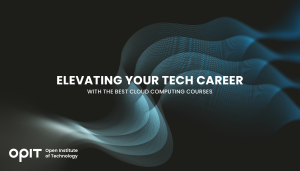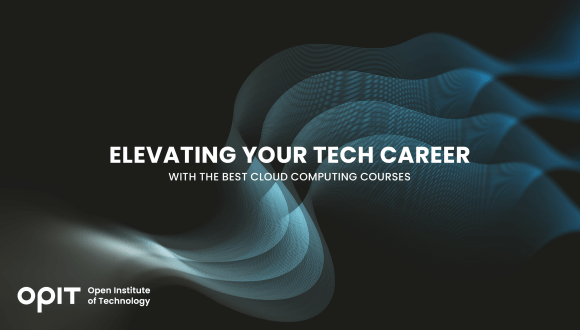

There was a time when cloud computing was nothing more than an interesting concept, but today the cloud computing industry is worth in the region of $371 billion. Businesses are leveraging the power and scalability of cloud computing due to its flexibility, enhanced security and cost savings realized through the reduction of expensive IT infrastructure maintenance.
Those professionals who are intent on becoming leaders in the ever-evolving world of cloud computing need appropriate skills and a world-class qualification, and that means finding the best cloud computing courses.
Understanding Cloud Computing and Its Courses
Cloud computing focuses on the delivery of computing services over the internet. These services can include database management, server hosting, storage, networking, online software solutions, and analytics. A recognized qualification in cloud computing will incorporate course content covering these areas and is essential for cloud innovators and future leaders.
Discovering the Best Cloud Computing Courses
A career in cloud computing provides a wealth of choice. There are qualifications that will prepare the student for a career as a Cloud Architect, Cloud Engineer, developer, or consultant. There are also more specialized careers involving cloud security or operations management. The key to a successful career in any of these fields is selecting the best cloud computing courses and qualifications.
Qualifications that will put the aspirant cloud expert on the fast track to success will be offered by recognized and certified educational institutions. Coursework should ideally cover both theoretical foundations and the practical application of skills.
Some criteria to consider when choosing the best cloud computing courses:
- Comprehensive Curriculum. Ensure that the coursework of their chosen qualification covers the skills required for career advancement. Ideally, it should include foundational cloud concepts, infrastructure management, security, practical implementation, and vendor-specific training, depending on the desired career path.
- Appropriate Teaching Methodology. Identify education providers that offer platforms including a mix of learning formats. Prioritize coursework that includes virtual instructor-led lectures, hands-on experience, real-world projects, and cloud sandboxes to allow for knowledge and application testing.
- Flexible Offerings. Many potential students will already have careers. Even those who do not hold full-time positions may be time-poor. The best cloud computing courses will make allowances for this by offering accessible and flexible options for study.
- Reputation and Accreditation. Prioritize offerings from reputable educational institutions that are acknowledged by industry leaders. The providers should be accredited by recognized regulatory bodies, offering industry leaders and organizations peace of mind when evaluating a potential employee.
Here are the top five cloud computing courses available on- and off-line to help get you started:
1. OPIT BSc in Modern Computer Science
The fully accredited OPIT BSc in Modern Computer Science provides students with the flexibility of online and fully remote coursework and study. The degree was developed to provide students with comprehensive foundation skills, both theoretical and practical. Courses include programming, software development, database management, cloud computing, cybersecurity, data science and artificial intelligence.
2. Introduction to Amazon Web Services Cloud Computing
Amazon Web Services (AWS) is the world’s leading cloud computing platform. This beginner-friendly “Introduction to Cloud Computing on AWS” qualification will provide hands-on, practical skills related to both fundamental cloud computing concepts and advanced AWS competencies.
The coursework consists of seven hours of easily accessible video and two articles. Content can be accessed online, and the successful student will receive a certificate of completion. The skills obtained during the study are perfect for those who want to progress to either a qualification as an AWS Certified Cloud Practitioner or an AWS Certified Solutions Architect.
3. Udemy – Getting Started With Cloud Computing – Level 1
This Udemy program provides a grounding in some fundamental cloud computing concepts. It includes course content such as cloud fundamentals and the five basic concepts that underpin cloud computing. The coursework also covers an introduction to service models such as SaaS, PaaS, and IaaS, and deployment models (private, public, hybrid, and community).
4. Coursera Cloud Computing Concepts (Part 1)
This flexible 23-hour course will provide foundational skills in distributed algorithms, distributed and cloud computing, and C++. Students will have access to industry experts to get a practical understanding of cloud computing and related subjects. Coursework includes hands-on projects that are relevant to individual career paths. A shareable ‘career certificate’ ideal for LinkedIn use is available to those obtaining the qualification.
5. Udemy Ultimate AWS Certified Solutions Architect Associate SAA-C03
This course is among the best cloud computing courses available. It is ideal for aspirant professionals who want to take their AWS qualifications to the next level. The coursework is flexible and allows students access to 800+ explanatory slides and a practice exam (with answer explanations). Students will have the opportunity to learn solution architecture analysis and database management, AWS fundamentals, and the implementation of real-world architecture using AWS.
The Skills You Gain From Top Cloud Computing Courses
Qualifications offered by accredited education institutions will provide both foundational and advanced competencies in cloud-related subjects. Students will obtain theoretical and practical knowledge that will advance their careers in the ever-evolving world of cloud computing.
A diverse skillset, including subjects such as database management, coding, and understanding the complexities of the various cloud solutions available is essential for those who are committed to a career in the cloud. However, these skills are not only applicable to the domain of cloud computing. Many are highly sought-after skills that are perfect for various IT and digital business roles, giving degree-holders options about their career trajectories.
Choosing the Right Course for Your Career Goals
The explosion of cloud applications and functionality provides enormous scope for a variety of career paths. These can include careers in cloud architecture, cloud application development, systems administration, front-end development, business consulting, cloud security, and data science, among many others.
The key to a successful cloud-based career is to understand the various career paths available and to ensure that the chosen path helps meet career objectives. An essential part of this journey is focusing on the best cloud computing courses.
How OPIT’s Cloud Computing Course in the BSc in Modern Computer Science Stands Out
The OPIT BSc in Modern Computer Science has become the preferred choice of those who want to fast-track their career in cloud computing. The coursework for the program provides the student with foundational, advanced, and real-world skills and leverages state-of-the-art tools and input from industry leaders and academic experts to provide actionable learning.
Flexibility and remote learning make this qualification the ideal choice for those who simply cannot commit to full-time study.
OPIT (Open Institute of Technology) is a fully licensed and accredited online higher education, a factor that can influence hiring decisions. It is recognized by the MFHEA under the European Qualification Framework (EQF) and the Malta Qualification Framework (MQF).
A Cloud Computing Qualification – Your Key to Success
The cloud is today part and parcel of the modern business environment, and it continues to evolve. This continued evolution provides incredible opportunities for the business leaders of tomorrow.
Carefully researching the best cloud computing courses is the key to success in the growing industry. However, the prospective student needs to take extra care when selecting their desired qualification and area of study. The coursework should complement the student’s chosen career path and offer the flexibility to study when and where they want.
OPIT is recognized as a premium education provider. The recognition of OPIT accreditation from leading standards authorities lends further weight to any qualification received from this respected institution. A qualification from OPIT opens the door to a stimulating and rewarding career at the cutting edge of cloud development.
Related posts

Source:
- Agenda Digitale, published on November 25th, 2025
In recent years, the word ” sustainability ” has become a firm fixture in the corporate lexicon. However, simply “doing no harm” is no longer enough: the climate crisis , social inequalities , and the erosion of natural resources require a change of pace. This is where the net-positive paradigm comes in , a model that isn’t content to simply reduce negative impacts, but aims to generate more social and environmental value than is consumed.
This isn’t about philanthropy, nor is it about reputational makeovers: net-positive is a strategic approach that intertwines economics, technology, and corporate culture. Within this framework, digitalization becomes an essential lever, capable of enabling regenerative models through circular platforms and exponential technologies.
Blockchain, AI, and IoT: The Technological Triad of Regeneration
Blockchain, Artificial Intelligence, and the Internet of Things represent the technological triad that makes this paradigm shift possible. Each addresses a critical point in regeneration.
Blockchain guarantees the traceability of material flows and product life cycles, allowing a regenerated dress or a bottle collected at sea to tell their story in a transparent and verifiable way.
Artificial Intelligence optimizes recovery and redistribution chains, predicting supply and demand, reducing waste and improving the efficiency of circular processes .
Finally, IoT enables real-time monitoring, from sensors installed at recycling plants to sharing mobility platforms, returning granular data for quick, informed decisions.
These integrated technologies allow us to move beyond linear vision and enable systems in which value is continuously regenerated.
New business models: from product-as-a-service to incentive tokens
Digital regeneration is n’t limited to the technological dimension; it’s redefining business models. More and more companies are adopting product-as-a-service approaches , transforming goods into services: from technical clothing rentals to pay-per-use for industrial machinery. This approach reduces resource consumption and encourages modular design, designed for reuse.
At the same time, circular marketplaces create ecosystems where materials, components, and products find new life. No longer waste, but input for other production processes. The logic of scarcity is overturned in an economy of regenerated abundance.
To complete the picture, incentive tokens — digital tools that reward virtuous behavior, from collecting plastic from the sea to reusing used clothing — activate global communities and catalyze private capital for regeneration.
Measuring Impact: Integrated Metrics for Net-Positiveness
One of the main obstacles to the widespread adoption of net-positive models is the difficulty of measuring their impact. Traditional profit-focused accounting systems are not enough. They need to be combined with integrated metrics that combine ESG and ROI, such as impact-weighted accounting or innovative indicators like lifetime carbon savings.
In this way, companies can validate the scalability of their models and attract investors who are increasingly attentive to financial returns that go hand in hand with social and environmental returns.
Case studies: RePlanet Energy, RIFO, and Ogyre
Concrete examples demonstrate how the combination of circular platforms and exponential technologies can generate real value. RePlanet Energy has defined its Massive Transformative Purpose as “Enabling Regeneration” and is now providing sustainable energy to Nigerian schools and hospitals, thanks in part to transparent blockchain-based supply chains and the active contribution of employees. RIFO, a Tuscan circular fashion brand, regenerates textile waste into new clothing, supporting local artisans and promoting workplace inclusion, with transparency in the production process as a distinctive feature and driver of loyalty. Ogyre incentivizes fishermen to collect plastic during their fishing trips; the recovered material is digitally tracked and transformed into new products, while the global community participates through tokens and environmental compensation programs.
These cases demonstrate how regeneration and profitability are not contradictory, but can actually feed off each other, strengthening the competitiveness of businesses.
From Net Zero to Net Positive: The Role of Massive Transformative Purpose
The crucial point lies in the distinction between sustainability and regeneration. The former aims for net zero, that is, reducing the impact until it is completely neutralized. The latter goes further, aiming for a net positive, capable of giving back more than it consumes.
This shift in perspective requires a strong Massive Transformative Purpose: an inspiring and shared goal that guides strategic choices, preventing technology from becoming a sterile end. Without this level of intentionality, even the most advanced tools risk turning into gadgets with no impact.
Regenerating business also means regenerating skills to train a new generation of professionals capable not only of using technologies but also of directing them towards regenerative business models. From this perspective, training becomes the first step in a transformation that is simultaneously cultural, economic, and social.
The Regenerative Future: Technology, Skills, and Shared Value
Digital regeneration is not an abstract concept, but a concrete practice already being tested by companies in Europe and around the world. It’s an opportunity for businesses to redefine their role, moving from mere economic operators to drivers of net-positive value for society and the environment.
The combination of blockchain, AI, and IoT with circular product-as-a-service models, marketplaces, and incentive tokens can enable scalable and sustainable regenerative ecosystems. The future of business isn’t just measured in terms of margins, but in the ability to leave the world better than we found it.

Source:
- Raconteur, published on November 06th, 2025
Many firms have conducted successful Artificial Intelligence (AI) pilot projects, but scaling them across departments and workflows remains a challenge. Inference costs, data silos, talent gaps and poor alignment with business strategy are just some of the issues that leave organisations trapped in pilot purgatory. This inability to scale successful experiments means AI’s potential for improving enterprise efficiency, decision-making and innovation isn’t fully realised. So what’s the solution?
Although it’s not a magic bullet, an AI operating model is really the foundation for scaling pilot projects up to enterprise-wide deployments. Essentially it’s a structured framework that defines how the organisation develops, deploys and governs AI. By bringing together infrastructure, data, people, and governance in a flexible and secure way, it ensures that AI delivers value at scale while remaining ethical and compliant.
“A successful AI proof-of-concept is like building a single race car that can go fast,” says Professor Yu Xiong, chair of business analytics at the UK-based Surrey Business School. “An efficient AI technology operations model, however, is the entire system – the processes, tools, and team structures – for continuously manufacturing, maintaining, and safely operating an entire fleet of cars.”
But while the importance of this framework is clear, how should enterprises establish and embed it?
“It begins with a clear strategy that defines objectives, desired outcomes, and measurable success criteria, such as model performance, bias detection, and regulatory compliance metrics,” says Professor Azadeh Haratiannezhadi, co-founder of generative AI company Taktify and professor of generative AI in cybersecurity at OPIT – the Open Institute of Technology.
Platforms, tools and MLOps pipelines that enable models to be deployed, monitored and scaled in a safe and efficient way are also essential in practical terms.
“Tools and infrastructure must also be selected with transparency, cost, and governance in mind,” says Efrain Ruh, continental chief technology officer for Europe at Digitate. “Crucially, organisations need to continuously monitor the evolving AI landscape and adapt their models to new capabilities and market offerings.”
An open approach
The most effective AI operating models are also founded on openness, interoperability and modularity. Open source platforms and tools provide greater control over data, deployment environments and costs, for example. These characteristics can help enterprises to avoid vendor lock-in, successfully align AI to business culture and values, and embed it safely into cross-department workflows.
“Modularity and platformisation…avoids building isolated ‘silos’ for each project,” explains professor Xiong. “Instead, it provides a shared, reusable ‘AI platform’ that integrates toolchains for data preparation, model training, deployment, monitoring, and retraining. This drastically improves efficiency and reduces the cost of redundant work.”
A strong data strategy is equally vital for ensuring high-quality performance and reducing bias. Ideally, the AI operating model should be cloud and LLM agnostic too.
“This allows organisations to coordinate and orchestrate AI agents from various sources, whether that’s internal or 3rd party,” says Babak Hodjat, global chief technology officer of AI at Cognizant. “The interoperability also means businesses can adopt an agile iterative process for AI projects that is guided by measuring efficiency, productivity, and quality gains, while guaranteeing trust and safety are built into all elements of design and implementation.”
A robust AI operating model should feature clear objectives for compliance, security and data privacy, as well as accountability structures. Richard Corbridge, chief information officer of Segro, advises organisations to: “Start small with well-scoped pilots that solve real pain points, then bake in repeatable patterns, data contracts, test harnesses, explainability checks and rollback plans, so learning can be scaled without multiplying risk. If you don’t codify how models are approved, deployed, monitored and retired, you won’t get past pilot purgatory.”
Of course, technology alone can’t drive successful AI adoption at scale: the right skills and culture are also essential for embedding AI across the enterprise.
“Multidisciplinary teams that combine technical expertise in AI, security, and governance with deep business knowledge create a foundation for sustainable adoption,” says Professor Haratiannezhadi. “Ongoing training ensures staff acquire advanced AI skills while understanding associated risks and responsibilities.”
Ultimately, an AI operating model is the playbook that enables an enterprise to use AI responsibly and effectively at scale. By drawing together governance, technological infrastructure, cultural change and open collaboration, it supports the shift from isolated experiments to the kind of sustainable AI capability that can drive competitive advantage.
In other words, it’s the foundation for turning ambition into reality, and finally escaping pilot purgatory for good.
Have questions?
Visit our FAQ page or get in touch with us!
Write us at +39 335 576 0263
Get in touch at hello@opit.com
Talk to one of our Study Advisors
We are international
We can speak in:


